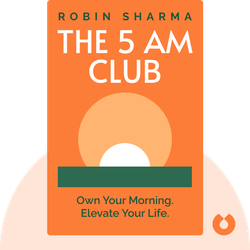Try Blinkist to get the key ideas from 7,000+ bestselling nonfiction titles and podcasts. Listen or read in just 15 minutes.
Start your free trial
Blink 3 of 8 - The 5 AM Club
by Robin Sharma

Zen and the Rediscovery of the Obvious
On Having No Head by Douglas Harding is a philosophical exploration of the nature of self and consciousness. It challenges traditional notions of identity and perception, inviting readers to view themselves and the world around them in a new way.
When he was 33 years old, the author had an experience that completely transformed the way he saw himself and the world around him. All of the ideas we’re about to explore are basically reflections on that one experience. So, before we dive into them, let’s take a step back and discover what the author experienced.
The key message here is: The author’s reflections were sparked by a life-changing experience in his early adulthood.
Here’s what happened. One day, the author was going for a walk in the Himalayas, when, all of a sudden, he stopped thinking. At that moment, he entered a simplified state of consciousness. He was no longer reasoning, imagining, or interpreting the world through language. For a short period of time, he even forgot his name and the fact that he was something called a “human being.”
Instead, he became focused entirely on the present moment and the immediate sensory experience he was having within it. Here, his attention was drawn to his visual field in particular, and he started mentally tracing the outlines of his own body. Following it downward, he found his pant legs ending in a pair of shoes. To the sides, he found his shirtsleeves ending in a pair of hands. And moving upward, he found a shirtfront ending with – well, nothing. There was absolutely nothing there on top of his shoulders!
Of course, we know what “should” have been there: his head. But when he looked around and focused solely on his immediate visual perceptions, he didn’t see any head. Instead, he just saw an empty space where his head “should” have been. It was a “headless void,” as he would later call it.
However, as he looked closer, he noticed there was something rather odd about the empty space of this headless void. It wasn’t really empty at all. In fact, it was quite the opposite. It was totally occupied – filled with grass, trees, hills, mountains, and the bright blue sky of the Himalayan landscape that he was looking at. The absence of his head made room for the presence of the entire world around him.
But it wasn’t just his head that was absent. There was something else that was noticeably missing from the vast and beautiful scene in front of him: the author himself. There was no “he” who was observing it. There was just the scene itself. The world was simply present – existing as a “self-luminous reality” that was “brightly shining in the clear air, alone and unsupported, mysteriously suspended in the void,” as he would later describe it.
That might sound rather esoteric or mystical, but to him, in that moment, it was as simple as could be, and it filled him with a sense of peace and joy.



On Having No Head (1961) is a one-of-a-kind classic of philosophy, spirituality, and mysticism. Combining empirical observations, mystical experiences, logical arguments, personal introspection, practical exercises, Zen Buddhism, and other Eastern spiritual traditions, its aim is to smash through the dualisms that lie beneath much of Western thought: subject and object, mind and body, self and non-self, internal and external world. In their place, the author contends that we can see ourselves and the world around us in a radically different way.
On Having No Head (1961) by Douglas Harding is a thought-provoking exploration of the nature of identity and perception. Here's why this book is worth reading:
It's highly addictive to get core insights on personally relevant topics without repetition or triviality. Added to that the apps ability to suggest kindred interests opens up a foundation of knowledge.
Great app. Good selection of book summaries you can read or listen to while commuting. Instead of scrolling through your social media news feed, this is a much better way to spend your spare time in my opinion.
Life changing. The concept of being able to grasp a book's main point in such a short time truly opens multiple opportunities to grow every area of your life at a faster rate.
Great app. Addicting. Perfect for wait times, morning coffee, evening before bed. Extremely well written, thorough, easy to use.
Try Blinkist to get the key ideas from 7,000+ bestselling nonfiction titles and podcasts. Listen or read in just 15 minutes.
Start your free trial
Blink 3 of 8 - The 5 AM Club
by Robin Sharma
What is the main message of On Having No Head?
The main message of On Having No Head is to help you realize the true nature of your own consciousness.
How long does it take to read On Having No Head?
The reading time for On Having No Head varies depending on the reader's speed, but it typically takes a few hours. The Blinkist summary can be read in around 15 minutes.
Is On Having No Head a good book? Is it worth reading?
On Having No Head is a fascinating exploration of self-awareness and consciousness. It offers unique insights and is definitely worth reading.
Who is the author of On Having No Head?
The author of On Having No Head is Douglas Harding.